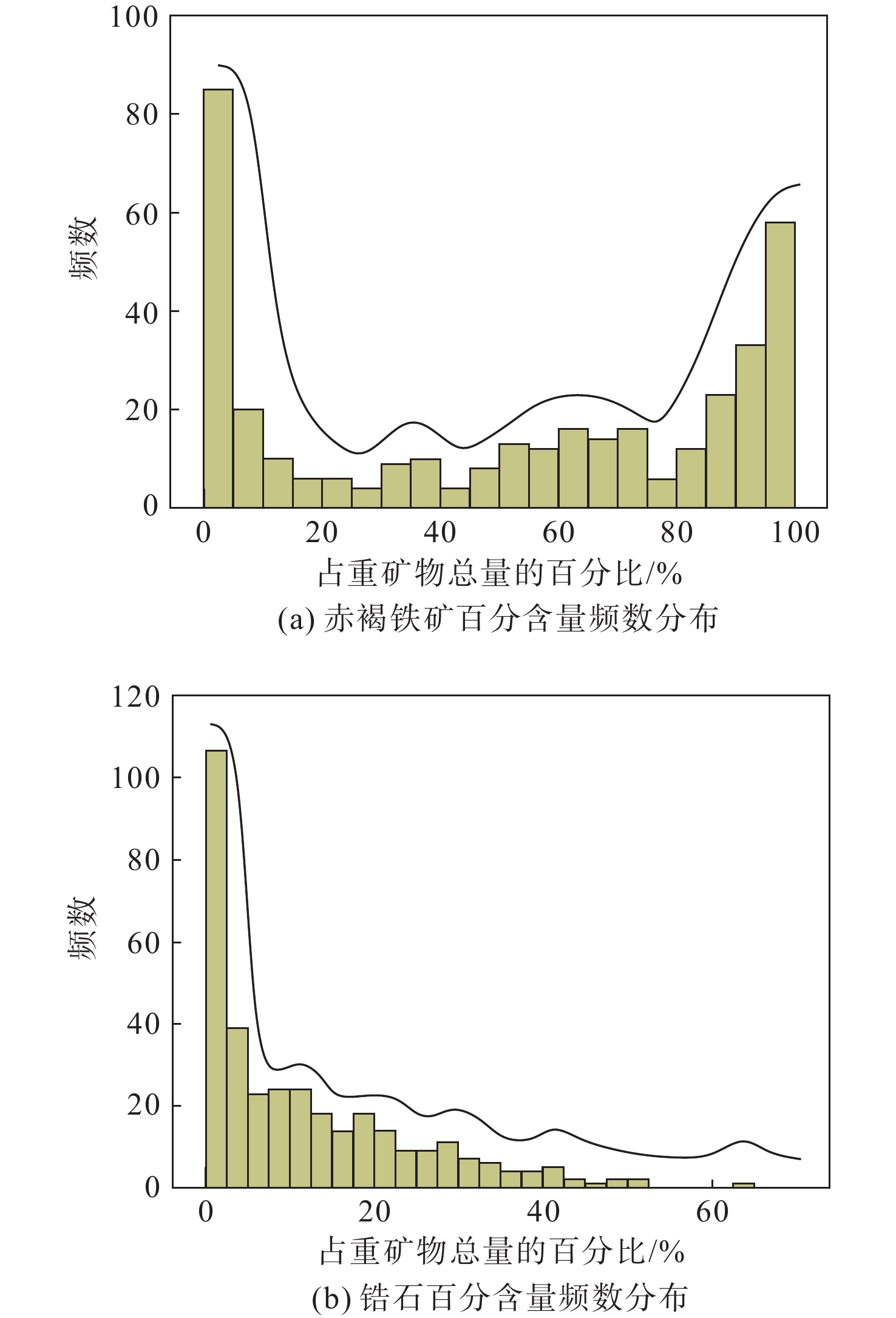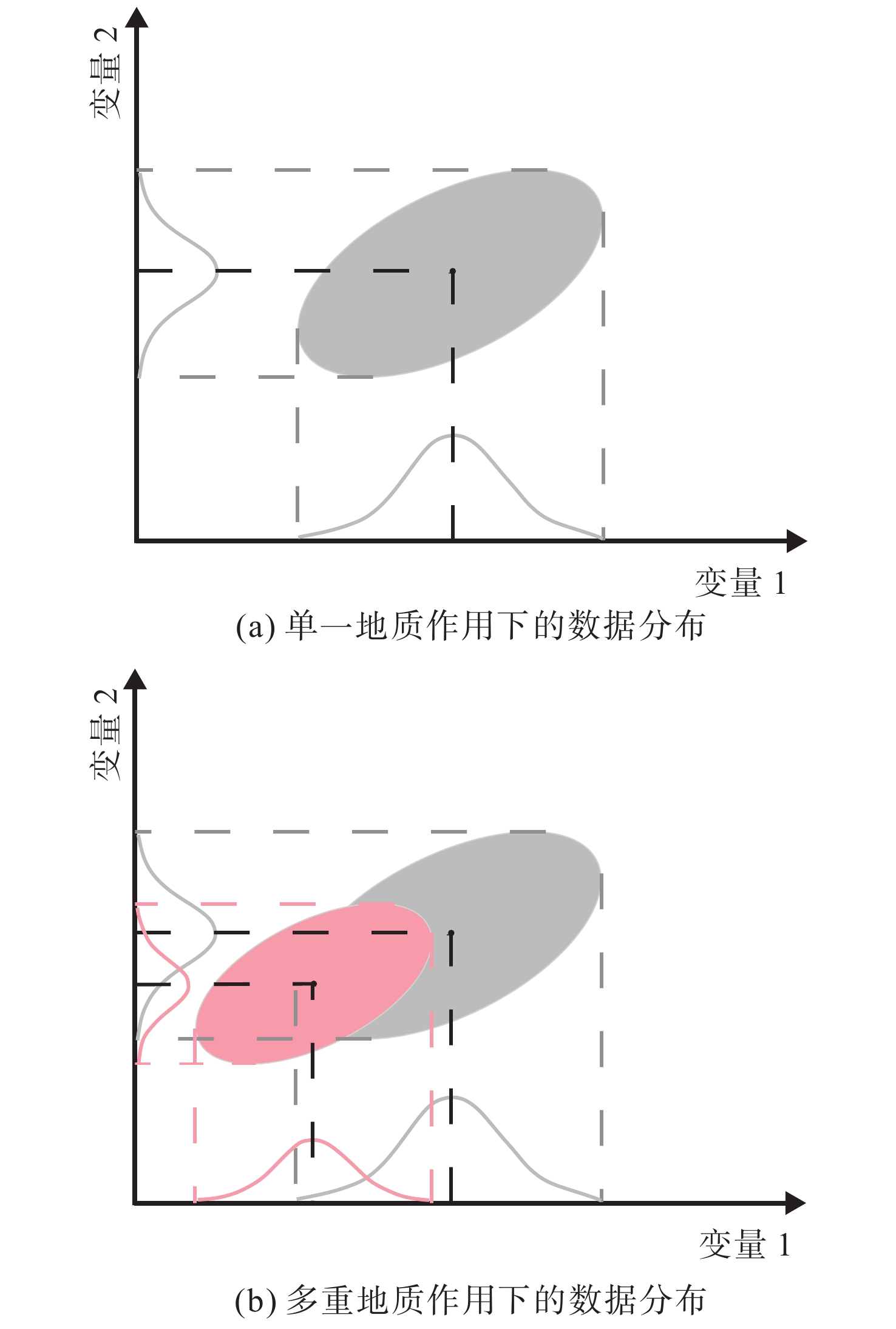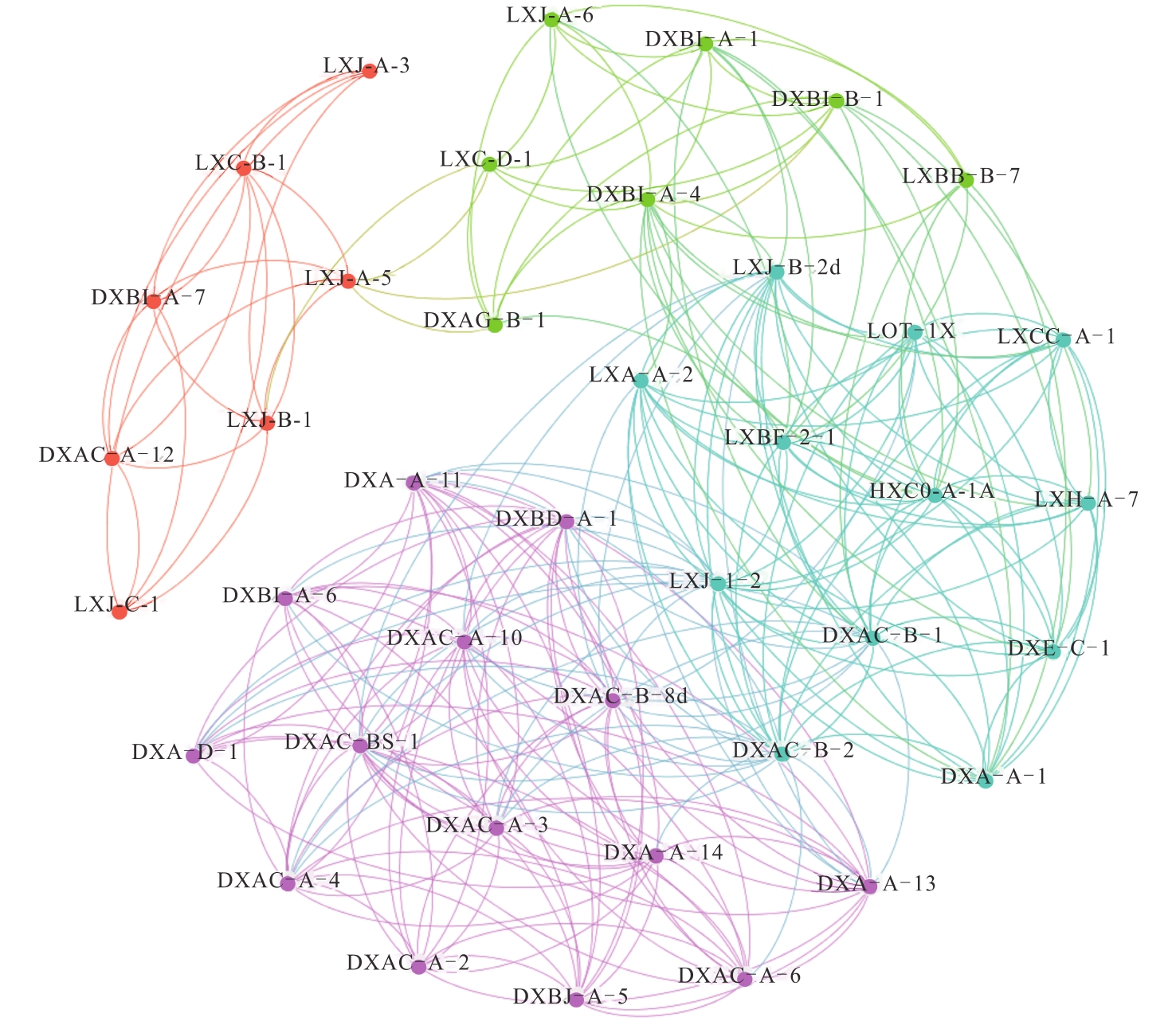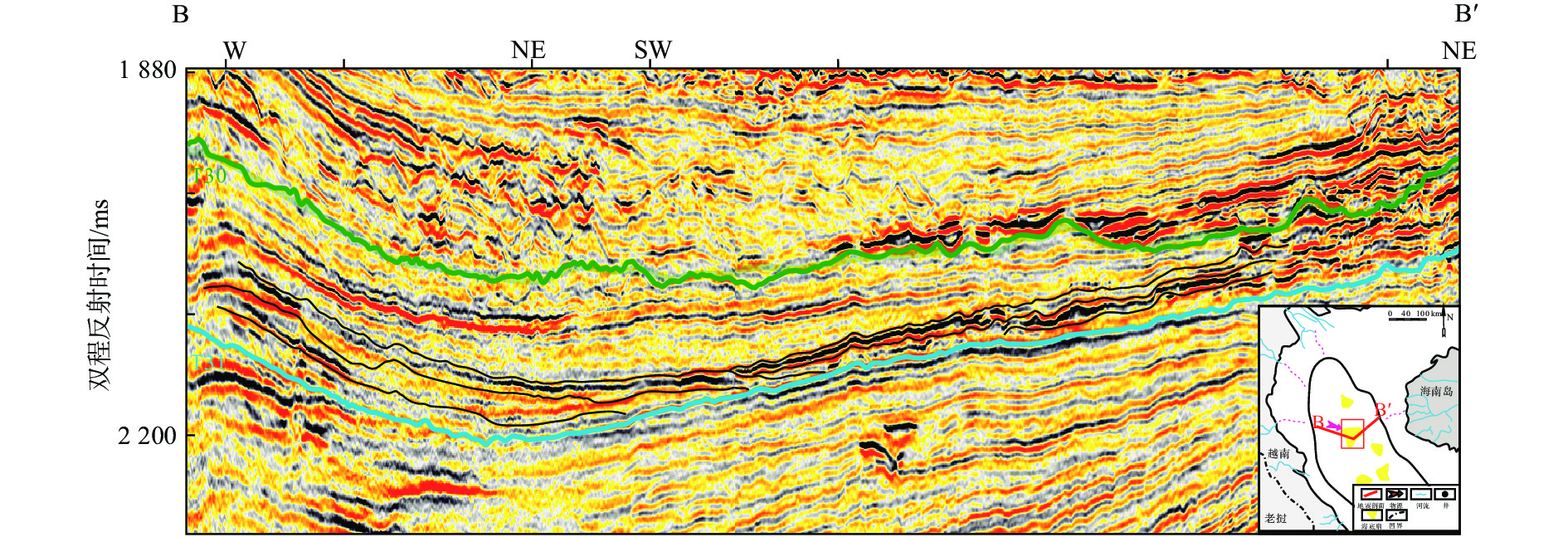Comprehensive identification of sediment source in the First Member of Huangliu Formation in Yinggehai Basin
-
摘要:
通过重矿物直观比对法确定了莺歌海盆地黄流组一段沉积物中各物源区的重矿物特征,并初步认识了其古母岩特征。研究区周围存在三大主要物源区,即海南岛、越南北部(红河)及越南中部。结果表明,越南物源以铁矿物、钛矿等沉积岩型重矿物组合为主;海南物源以锆石、电气石、金红石等酸性火山岩型重矿物组合为主。基于余弦距离及皮尔森相关系数的谱系聚类结果表明,莺歌海盆地黄流组一段锆石、电气石、金红石、锐钛矿、白钛矿等矿物受成岩作用影响较小,为该时期的稳定矿物组合。综合稳定重矿物复杂拓扑网络、地震属性、地震剖面及锆石年龄等方法对主导物源区进行划分,确定了莺歌海盆地东方13区及东方1区的部分扇体主要受控于越北红河物源,东方13区及东方29区的绝大多数扇体主要受越中物源及海南北部物源的双重影响,乐东区受控于海南南部物源。基于海南南部物源的古物源分布模式,建立了重矿物-地震特征-锆石年代学的物源识别方法。
Abstract:The characteristics of heavy mineral assemblages from each sediment provenance of the Huangliu Formation in the Yinggehai Basin were determined in intuitive comparison method, from which the characteristics of ancient parent rockswere clarified. There are three main provenances around the research area, namely Hainan Island, northern Vietnam (Red River), and central Vietnam. Results indicate that the provenances from Vietnam are mainly composed of sedimentary rock typed iron and titanium minerals, and other sedimentary rock typed ones alike, while the Hainan provenance is mainly composed of acidic volcanic rock typed heavy mineral assemblages including zircon, tourmaline, and rutile. The spectral clustering results based on cosine distance and Pearson correlation coefficient show that zircon, tourmaline, rutile, anatase, and perovskite in the Huangliu Formation are less affected by diagenesis and thus are stable minerals . The dominant source areas were divided using complex topological networks of stable heavy minerals, seismic attributes, seismic profiles, and zircon ages. It was determined that some fan bodies in the Dongfang 13 and 1 areas of the Yinggehai Basin were controlled mostly by the northern Vietnam (Red River) provenance, while the vast majority of fans in the Dongfang 13 and 29 areas were affected jointly by the central Vietnam and northern Hainan provenances. The Ledong area was controlled by the southern Hainan source. Therefore, a comprehensive method to determine provenance was established combining heavy mineral assemblage, seismic attribute, and zircon chronology.
-

-
表 1 黄流组一段取芯井重矿物含量范围
Table 1. Content range of heavy minerals in coring wells in the First Member of Huangliu Formation
锆石 电气石 石榴石 帘石类 磁铁矿 赤褐铁矿 白钛矿 绿泥石 角闪石 榍石 金红石 十字石 最大值/% 64.2 20.2 37.7 3.2 38.7 99.8 92.9 3.2 8.9 9.5 6.7 9.5 最小值/% 0.3 0.3 0.2 0 0 0.9 0.2 0 0.1 0.2 0.2 0 板钛矿 辉石 红柱石 磷灰石 独居石 硬石膏 重晶石 碳酸盐 闪锌矿 海绿石 锐钛矿 黄铁矿 最大值/% 1.8 38.1 0.7 3.5 3.2 4.1 95.6 9.1 1.2 1.3 19.4 89.9 最小值/% 0 0.1 0.2 0 0 0 0.2 0.2 0.2 0 0.3 0.2 蓝锥矿 刚玉 橄榄石 黑云母 萤石 硬绿泥石 蓝晶石 铜矿物 未定矿 尖晶石 富铝红柱石 霓辉石 最大值/% 0.2 8.5 0.8 3.2 0.4 3 2.7 0.6 0.3 3.5 1.4 11.2 最小值/% 0 0.2 0 0.4 0 0 0 0 0 0.2 0 0 表 2 不同母岩重矿物组合特征[32]
Table 2. Characteristics of heavy mineral assemblies from different parent rocks [32]
重矿物 母岩 磷灰石、黑云母、板钛矿、角闪石、独居石、白云母、金红石、榍石、电气石、锆石 酸性火山岩 锡石、蓝线石、萤石、石榴石、独居石、白云母、黄玉、电气石、黑钨矿、磷钇矿 花岗伟晶岩 辉石、铬铁矿、透辉石、紫苏辉石、钛铁矿、磁铁矿、橄榄石、尖晶石 基性火山岩 红柱石、硅镁石、刚玉、石榴石、金云母、十字石、黄玉、浮山石、硅灰石、黝帘石 接触变质岩 红柱石、硬绿泥石、绿帘石、石榴石、蓝闪石、蓝晶石、硅线石、十字石、榍石、黝帘石–斜黝帘石 热动力变质岩 重晶石、铁矿、白钛石、金红石、电气石、锆石 再旋回沉积岩 指数名称 涉及矿物 指数定义 GZi 石榴子石、锆石 100×石榴子(/ 石榴子石+锆石) RZi TiO2矿物、锆石 100×TiO2矿物(/ TiO2矿物+锆石) RuZi 金红石、锆石 100×金红石(/ 金红石+锆石) ZTR 锆石、电气石、金红石 100×(锆石+电气石+金红石)/透明重矿物 POS 辉石、橄榄石、尖晶石 100×(辉石+橄榄石+尖晶石)/透明重矿物 %ZR 锆石、金红石、电气石 100×(锆石+金红石)(/ 锆石+金红石+电气石) %Op 所有重矿物 100×不透明重矿物/总的重矿物 -
[1] 田豹,李维锋,祁腾飞,等. 重矿物物源分析研究进展[J]. 中国锰业,2017,35(1):107-109,115.
[2] ROSER B P,KORSCH R J. Provenance signatures of sandstone-mudstone suites determined usingdiscriminant function analysis of major element data[J]. Chemical Geology,1988,67(1/2):119-139.
[3] 徐杰,姜在兴. 碎屑岩物源研究进展与展望[J]. 古地理学报,2019,21(3):379-396.
[4] EYNATTEN V,DUNKL H I. Assessing the sediment factory:The role of single grain analysis[J]. Earth-Science Reviews,2012,115(1/2):97-120.
[5] 谢玉洪,童传新,裴健翔,等. 莺歌海盆地黄流组二段碎屑锆石年龄与储层物源分析[J]. 大地构造与成矿学,2016,40(3):517-530.
[6] 姜龙杰,孙志鹏,翟世奎,等. 琼东南盆地深水区钻井岩屑稀土元素地球化学特征及其对沉积物源和环境的指示[J]. 海洋科学,2018,42(4):89-100.
[7] 毛光周,刘池洋. 地球化学在物源及沉积背景分析中的应用[J]. 地球科学与环境学报,2011,33(4):337-348.
[8] 杨仁超,李进步,樊爱萍,等. 陆源沉积岩物源分析研究进展与发展趋势[J]. 沉积学报,2013,31(1):99-107.
[9] 刘为,邓广君,应明雄,等. 莺歌海盆地深层超高温超高压天然气勘探新问题及对策[J]. 世界地质,2021,40(1):107-114.
[10] 冯冲,黄志龙,童传新,等. 莺歌海盆地地层压力演化特征及其与天然气运聚成藏的关系[J]. 吉林大学学报(地球科学版),2013,43(5):1341-1350.
[11] 宋瑞有,于俊峰,韩光明,等. 莺歌海盆地底辟类型及侵入方式[J]. 世界地质,2017,36(4):1235-1243.
[12] 金博,刘震,李绪深. 莺歌海盆地天然气底辟优势聚集规律及勘探意义[J]. 吉林大学学报(地球科学版),2009,39(2):196-204.
[13] 张建新,范彩伟,谭建财,等. 莺歌海盆地中新世沉积体系演化特征及勘探意义[J]. 地质科技情报,2019,38(6):51-59.
[14] 郭令智,钟志洪,王良书,等. 莺歌海盆地周边区域构造演化[J]. 高校地质学报,2001,7(1):1-12.
[15] 张启明. 莺-琼盆地的演化与构造-热体制[J]. 天然气工业,1999,19(1):36-42.
[16] 李伟,刘平,艾能平,等. 莺歌海盆地乐东地区中深层储层发育特征及成因机理[J]. 岩性油气藏,2020,32(1):19-26.
[17] 杨东辉. 莺歌海盆地拗陷期构造变形特征及古构造环境探索[D]. 北京: 中国石油大学(北京), 2019.
[18] 向宏发,韩竹军,虢顺民,等. 红河断裂带大型右旋走滑运动与伴生构造地貌变形[J]. 地震地质,2004,26(4):597-610.
[19] 陈文寄,李齐,汪一鹏. 哀牢山-红河左旋走滑剪切带中新世抬升的时间序列[J]. 地质论评,1996,42(5):385-390.
[20] LELOUP P H,HARRISON T M,RYERSON F,et al. Structural,petrological and thermal evolution of a Tertiary ductile strike-slip shear zone,Diancang Shan,Yunnan[J]. Journal of Geophysical Research,1993,98(B4):6715-6743. doi: 10.1029/92JB02791
[21] 尤丽,范彩伟,吴仕玖,等. 莺歌海盆地乐东区储层碳酸盐胶结物成因机理及与流体活动的关系[J]. 地质学报,2021,95(2):578-587.
[22] 王振峰,裴健翔,郝德峰,等. 莺-琼盆地中新统大型重力流储集体发育条件、沉积特征及天然气勘探有利方向[J]. 中国海上油气,2015,27(4):13-21.
[23] 谢玉洪,范彩伟. 莺歌海盆地东方区黄流组储层成因新认识[J]. 中国海上油气,2010,22(6):355-359,386.
[24] 谢玉洪,王振峰,解习农,等. 莺歌海盆地坡折带特征及其对沉积体系的控制[J]. 地球科学,2004,29(5):569-574.
[25] 徐德明,桑隆康,马大铨,等. 海南岛中新元古代花岗质岩类的成因及其构造意义[J]. 大地构造与成矿学,2008,32(2):247-256.
[26] 李孙雄,云平,范渊,等. 海南岛琼中地区琼中岩体锆石U-Pb年龄及其地质意义[J]. 大地构造与成矿学,2005,29(2):227-233,241.
[27] HOANG L V,WU F Y,CLIFT P D,et al. Evaluating the evolution of the Red River system based on in situ U-Pb dating and Hf isotope analysis of zircons[J]. Geochemistry Geophysics Geosystems,2013,10(11):1-20.
[28] 王策. 莺歌海盆地上中新统—更新统储层物源识别: 来自碎屑锆石U-Pb年代学和地球化学制约 [D]. 广州: 中国科学院研究生院(广州地球化学研究所), 2016.
[29] ROGER F,JOLIVET M,LACASSIN R,et al. Long and complex thermal history of the Song chay metamorphic dome(northern Vietnam)by multi-system geochronology[J]. Tectonophysics,2000,321(4):449-466. doi: 10.1016/S0040-1951(00)00085-8
[30] 许苗苗,魏晓椿,杨蓉,等. 重矿物分析物源示踪方法研究进展[J]. 地球科学进展,2021,36(2):154-171.
[31] GARZANTI E,ANDÒ S. Chapter 20 heavy mineral concentration in modern sands:implications for provenance interpretation[J]. Developments in Sedimentology,2007,58(7):517-545.
[32] BOGGS S. Petrology of Sedimentary Rocks [M]. Cambridge: Cambridge University Press, 2009: 600.
[33] MORTON A C,HALLSWORTH C. Identifying provenance specific features of detrital heavy mineral assemblages in sandstones[J]. Sedimentary Geology,1994,90(3):241-256.
[34] GARZANTI E,ANDÒ S. Heavy minerals for junior wood chucks[J]. Minerals,2019,9(3):148. doi: 10.3390/min9030148
[35] MAHALANOBIS P C. On the generalized distance in statistics[J]. National lnstitute of Science of India,1936,2:49-55.
[36] ROUSSEEUW P J,DRIESSEN K V. A fast algorithm for the minimum covariance determinant estimator[J]. Technometrics,1999,41(3):212-223. doi: 10.1080/00401706.1999.10485670
[37] 吴娟. 基于余弦距离的智能拼图算法的应用研究[J]. 信息与电脑(理论版),2022,34(2):56-58,73.
[38] GIBBONS J D, CHAKRABORTI S. Nonparametric statistical inference [M]. New York: M Dekker, 1992: 122.
[39] 纪宏金, 时艳香, 陆继龙. 地球化学数据统计分析 [M]. 长春: 吉林大学出版社, 2013: 22, 142.
[40] 段忠祥. 复杂网络中个体行为一致性控制研究[J]. 计算机技术与发展,2019,29(9):102-105,140.
[41] PENG N,ZHU X Y,LIU Y S. Complex network dynamics of the topological structure in a geochemical feld from the Nanling area in South China[J]. Nature,2020,10(1):19826.
[42] 梁世娇,柴争义. 基于多目标自适应Memetic算法的复杂网络社区检测[J]. 江苏大学学报(自然科学版),2020,41(3):262-267,280.
[43] 梁世娇,柴争义. 基于节点亲密度的标签传播重叠社区发现算法[J]. 云南大学学报(自然科学版),2020,42(1):58-65.
-



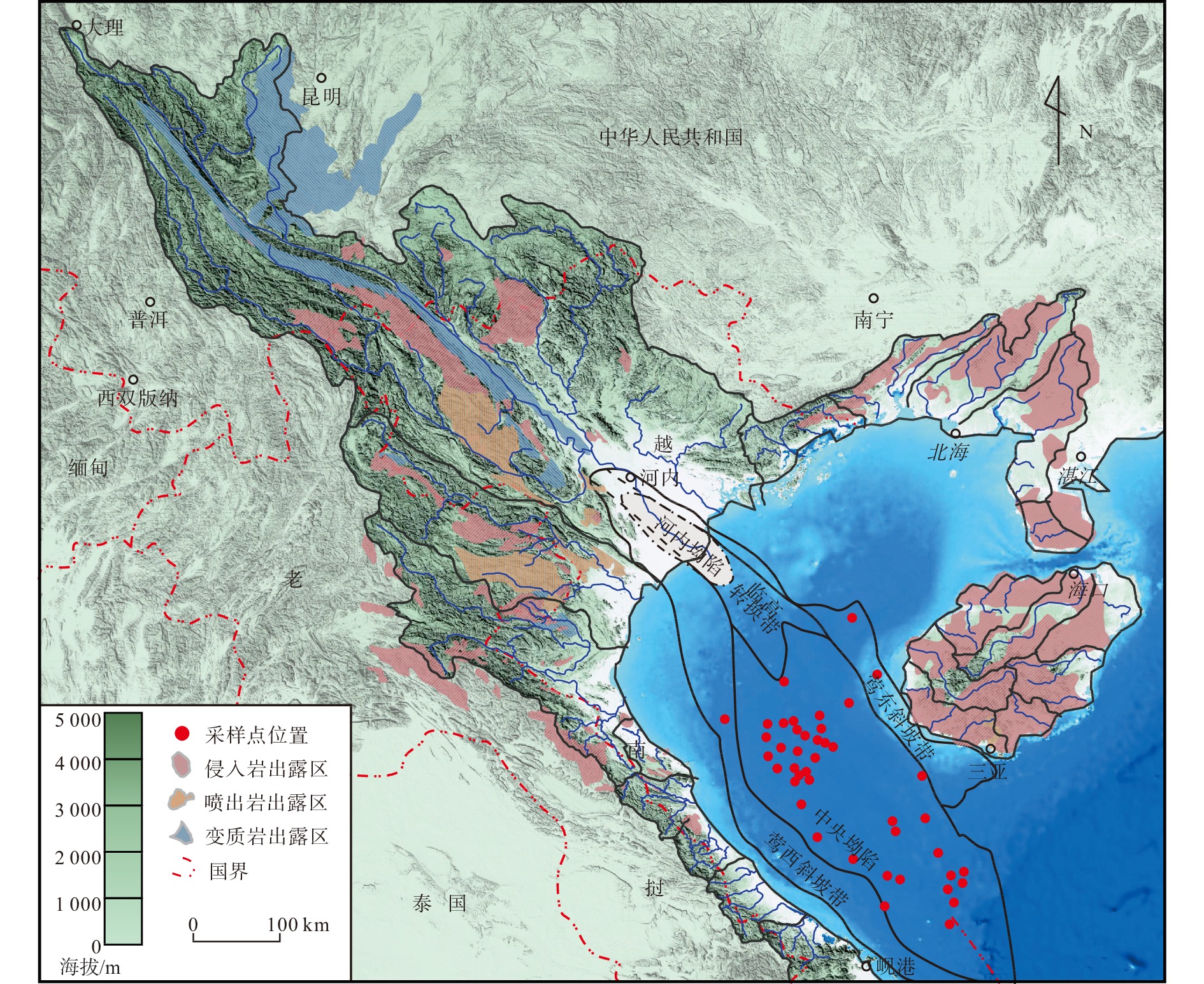
 下载:
下载:



